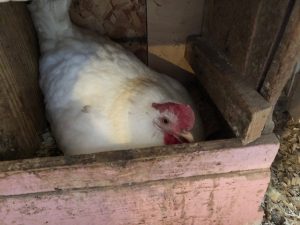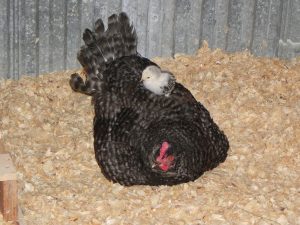Some chicken traits are both admirable and frustrating. Patience is an example.
People often lack patience. They grit their teeth waiting at a red light, and zoom off the second it turns green. Instant gratification is expected. Fortunately, in this fast-paced world, a broody hen teaches us the merits of calmness and patience.
At one time, the only way to get new chicks was to let a broody hen warm egg for a 21-day incubation period. Nature programmed hens to develop a maternal urge, usually in the spring, and raise babies. After filling her nest with fertile eggs she’ll fluff up her feathers, develop a new vocabulary of clucks, go into a trance-like state and patiently settle down on her precious eggs until new babies appear.

A broody hen is a model of persistence and patience. She’ll sit and sit, only briefly leaving the nest to eat, drink, and poop. Then she’s back warming her eggs. If you remove her, she’ll go right back. If you take her eggs, she’ll find others to sit on. She’s determined.
Chickens are smart but can’t count. People know it takes 21 days for eggs to hatch. A broody hen knows she’s sitting on eggs but doesn’t know how long she’s been at it or how many days are left before chicks emerge. So, she patiently sits and waits until something happens.
If her eggs don’t hatch, often because they are infertile, she’ll sit and sit until eventually they all break or spoil. That may take weeks. While sitting she won’t lay any new eggs.
Today’s best laying breeds rarely go broody. Anyone wanting maximum egg production should choose these breeds or hybrids. In contrast, many old-fashioned brown egg layers often go broody. The tendency of any breed’s broodiness is listed in Hoover’s catalog, but it’s only a rule of thumb. Chickens are individuals. Once in a while a “non broody” hen will choose motherhood. Occasionally notoriously broody breeds will opt out of motherhood and never go broody.
What To Do with a Broody Hen
Chicken experts suggest discouraging broodiness by isolating a hen in a sparsely furnished cage lacking a nest and litter. It may break her broody spell but deprives her of the joy of motherhood.
Watching a hen hatch and raise babies thrills people and is a wonderful learning opportunity for children. It’s also an easy way to gain replacement birds. No artificial brooding is needed. Mom does the work.

There is no way to encourage a hen to go broody. Since most small flocks lack a rooster, eggs are infertile and won’t hatch. When a hen goes broody there are a few ways to manage her.
If no chicks are wanted, replace real eggs with either wooden or ceramic nest eggs……or even golf balls. She’ll keep them warm for weeks until eventually she gives up.
Two strategies work if new chicks are wanted. One is to remove infertile eggs and replace them with fertile eggs acquired from someone who has a flock rooster. A few hatcheries sell fertile eggs that can be shipped in the mail.
Lacking fertile eggs there’s a way to trick the hen into raising babies.
Order chicks from Hoovers as soon as the hen settles down in incubation. Chicks should be timed to arrive in about three weeks. Bring the box of peeping babies into the coop after dark. Carefully remove the old eggs or golf balls from under the hen and replace them with chicks. Mom will wake from her trance and raise her babies.
A big fluffy hen, like an Orpington or Brahma, can tend up to 15 chicks.

Chickens are individuals. Some hens go broody. Others don’t. Some broody hens give up quickly if her eggs won’t hatch, while others will sit for weeks. Their behavior may seem quirky but is always fun to watch.